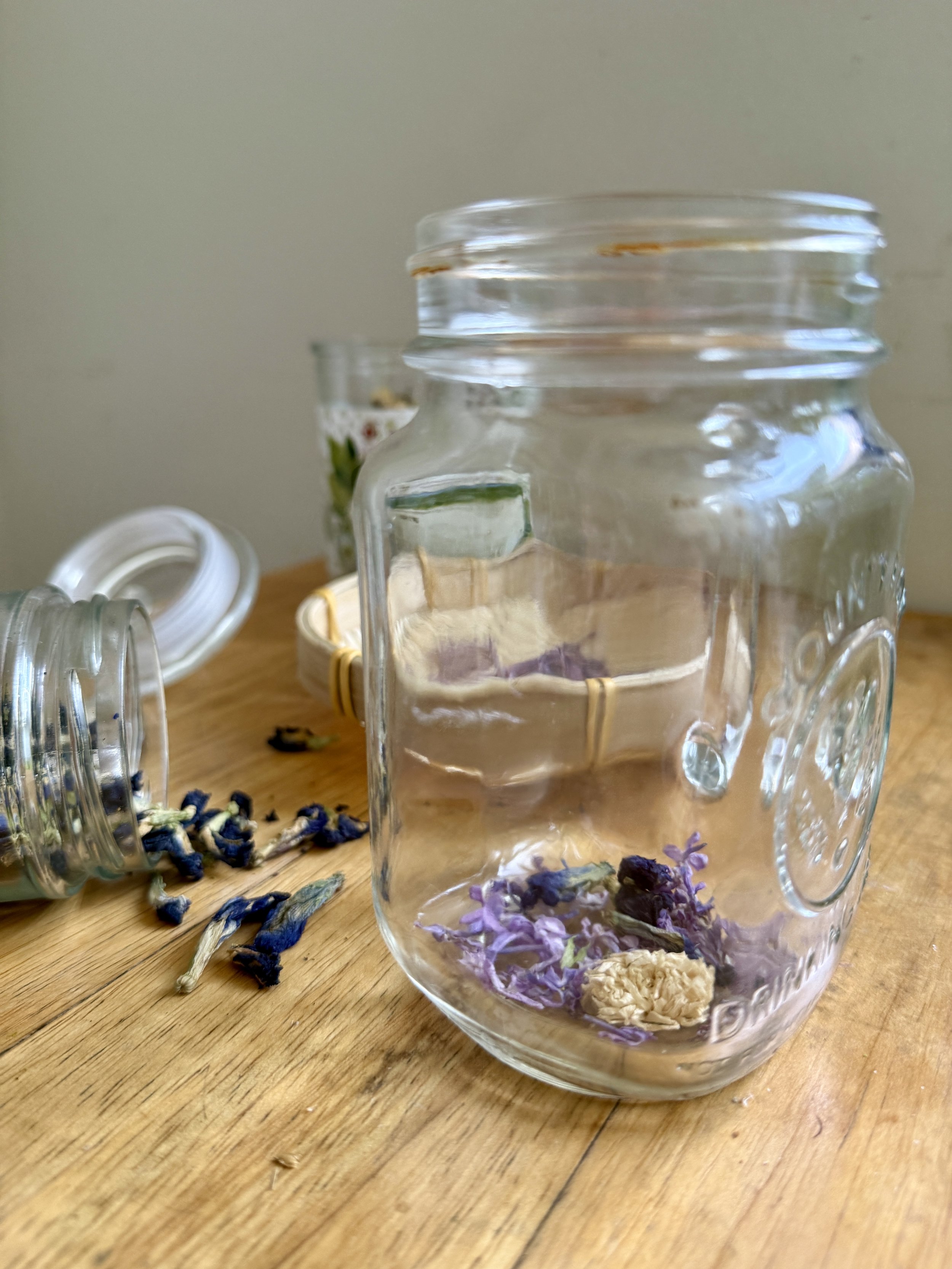Lilac, Butterfly Pea Flower & Chrysanthemum Infusion
Lilac season is truly such a magical time of year. They’re fleeting & before you know it, are gone. Lilac season only lasts for a few weeks and we are nearing the end of their life cycle which marks mid-winter so beautifully.
I always try to look for lilacs blooming during this season and am not always successful. But, this year I was. As I was walking the dogs with my father, Rosie stopped to smell the lilacs a neighbor was trimming. Her little nose wafted toward their magical aura and she kept pulling me over. Before you know it, I was asking the owner if we could come and smell the lilacs and all of a sudden I had a giant handful of them to make into an assortment of goodies.
I went back a couple of days later (at her suggestion) while she was on vacation in Aruba and trimmed the rest of the buds for myself.
So far I’ve made a lilac salt, a water infusion, a tea and have dried the rest for oil infusions or syrups.
History, Lore & Uses:
🌿 Butterfly Pea Flower (Clitoria ternatea):
History & Lore:
Butterfly Pea Flowers are native to Southeast Asia and have been used for centuries in Ayurvedic medicine as a medhya rasayana—aka: a tonic for the mind and nerves. It was believed to sharpen memory, calm the mind, and protect against internal heat and inflammation.
In Thailand and Malaysia, the flower is known as dok anchan and is traditionally used in ceremonial offerings and celebratory drinks. Its color-shifting nature was thought to represent transformation and inner alchemy.
It’s beautiful blue hue is often associated with the throat chakra, the center known for enhancing communication and inner truth. Some believed it could reveal hidden truths—both emotionally and spiritually.
Gut + Nervous System Benefits:
Butterfly Pea Flower is rich in anthocyanins, which have antioxidant and anti-inflammatory effects that may support the gut lining and reduce oxidative stress.
It may also improve the gut-brain communication by calming the nervous system. Something so important for those of us with autoimmune issues, depression and hormonal imbalances
Traditionally, Clitoria Ternatea has been used in Ayurveda to enhance mental clarity and reduce internal heat.
🌸 Lilac Blossoms (Syringa spp.)
History & Lore:
Lilacs originate from Eastern Europe and Asia and were revered in ancient Greek mythology, in which the nymph Syringa fled from the forest god, Pan, and transformed into the lilac bush.
In the Victorian era, lilacs symbolized one’s first emotions of love and innocence, making them a common spring bloom in women’s health elixirs and floral baths.
In the 18th and 19th century America and Europe, lilacs were steeped in vinegar or honey for spring cleanses, used to “wake up” the liver and lymph after long winters. Some herbalists called it “the maiden’s tonic” for its gentle hormonal support.
This is still a fantastic way to use lilac blossoms.
Lilacs were also brewed into wine and used as a support during menstruation.
Hormone + Liver Support:
Traditionally, lilacs were used for lymphatic drainage and as a gentle liver detox, helping your body process hormonal metabolites.
They may help relieve bloating and digestive discomfort, especially from excess estrogen or stress.
Lilacs are mildly astringent, meaning they can tone the body’s tissues and help regulate fluid retention.
Interesting Fact:
In 19th-century folk medicine, lilac was used as a spring liver tonic and even brewed into wine for menstrual support.
🌼 Chrysanthemum Blossoms (Chrysanthemum morifolium)
History & Lore:
In Traditional Chinese Medicine (TCM), chrysanthemum blossoms are known to be a deeply and has been used for over 2,000 years to cool internal heat, support liver function, and clear the body of inflammation, fever, or emotional agitation.
Chrysanthemums have been used for centuries in East Asia to cool excess heat from long work hours, screen time, or emotional tension.
In China and Japan, the chrysanthemum symbolizes nobility, longevity, and clarity. The Japanese Imperial Seal is a chrysanthemum, and the flower is honored during the Festival of Happiness (Kiku no Sekku), celebrated every autumn.
Buddhists often used chrysanthemum in temple offerings, believing its light fragrance could purify the air and calm the mind. It’s considered to be a flower that helps us transition through life with grace and acceptance.
Thyroid + Inflammation Support:
Known in TCM to clear heat and soothe the liver and eyes. It can also be beneficial for hyperactive or inflamed thyroid.
Contains flavonoids and volatile oils that have anti-inflammatory, anti-fungal, and antimicrobial properties.
Chrysanthemum also acts as a mild nervine, helping to relax the body and mind without sedation.
Ingredients:
(Makes 1 single, 2 cup serving)
1 Chrysanthemum blossom
3-5 butterfly pea flower blossoms
2 tsp fresh lilacs or 1 tsp dried
Preparations:
Add the blossoms to a mug or jar or your choosing. Pour 2 cups of boiling water over them and infuse for 20-30 minutes or up to 2 hours.
A longer infusion will provide stronger taste and medicinal properties.
Strain your infusion and drink.





